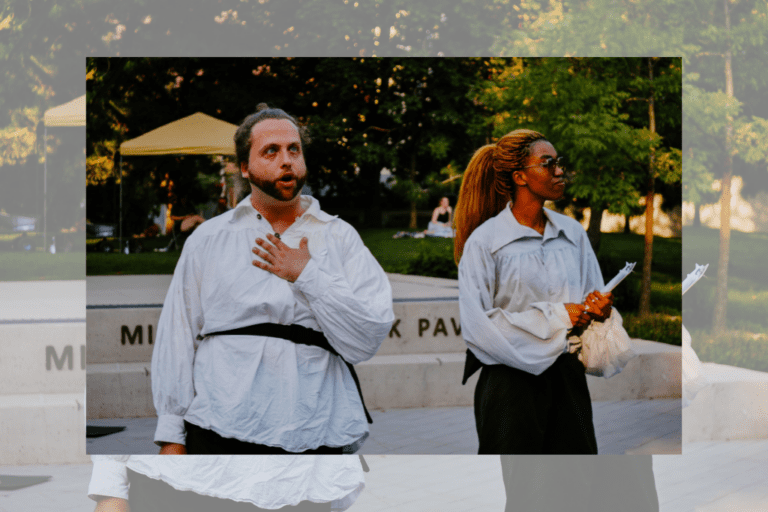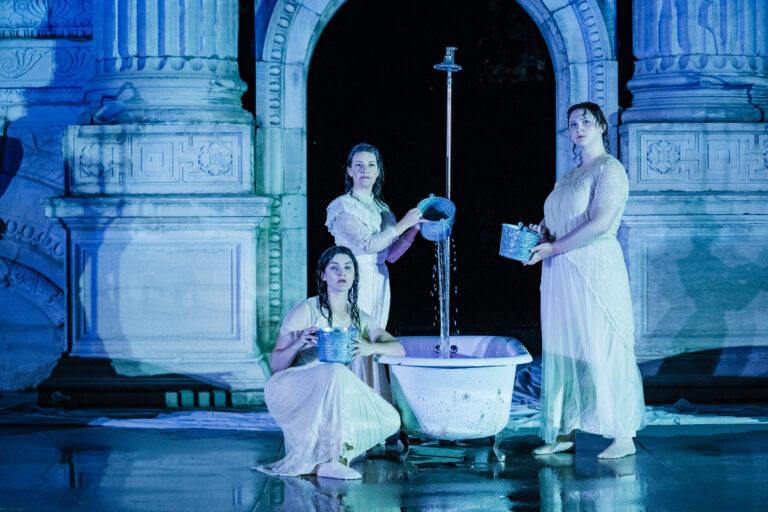REVIEW: CoMotion Festival at Harbourfront Centre
“Deaf and disabled artists are not included in this festival: we are this festival… So, welcome to our festival; welcome to our space; and welcome to our world.”
As Alex Bulmer concluded her opening remarks on the stage of Harbourfront Centre, the audience erupted in applause, both audible and silent. The inaugural CoMotion Festival at Harbourfront Centre had officially begun, and the excitement in the air was palpable.
Opening night was one of the better planned events I’ve attended in quite some time. The food was plentiful and delicious, the opening remarks were short and succinct, and the evening’s special guest, comedian Courtney Gilmour, delighted the eager crowd in a hilarious 20-minute set. Invited guests received a coveted red wristband (I’m not ashamed to admit I love a good wristband at an event), and staff throughout the building were ready to direct visitors wherever they needed to go.
But beyond being an event planner’s dream, the entire festival has been meticulously and intentionally planned with a focus on accessibility.
From the design of the building to the presentation and diversity of the galleries and displays throughout the space, CoMotion Festival offers guests a new way to experience art. Immediately upon entering the building on opening night, we were handed golf pencils and scavenger hunt cards crafted by Vanessa Dion Fletcher, a Lenape and Potawatomi neurodiverse artist. The card contained multiple prompts, inviting us to record the words that resonated with us as we moved through the many exhibition spaces. A series of wall-mounted installations and murals offered visitors a tactile experience, encouraging us to touch and explore the art in a different way. QR codes adorned every placard, providing an alternate method of accessing each artists’ bio, artist statement, and image description, and the venue offered a number of devices for those without smartphones or access to the codes. At every turn, visitors were invited to interact with the art in a new way, providing a multifaceted and engaging experience to every visitor who walked through the doors.
When I sat down with Bulmer, the curator of the CoMotion Festival, for an interview before her keynote speech, she noted that the committed yet seriously underrepresented community of Deaf and disabled artists has been calling for opportunities to showcase their work, and the Harbourfront Centre has been listening.
“I never imagined something of this scale… To be accepted and welcomed by one of Canada’s premiere arts and cultural institutions is incredibly affirming.”
She sat back in her chair and smiled. It’s clear that Bulmer was in her element: I spent the evening watching her move through the space, interacting with every visitor who crossed her path. She was warm, she was welcoming, and her passion for the festival radiated throughout the room. I spoke with Bulmer last year when she adapted her solo show, May I Take Your Arm, a collaboration with Red Dress Productions, for digital presentation through Theatre Passe Muraille. Before CoMotion, I’d never shared physical space with her. She is a commanding presence; this is her space, her festival, and she is ready to share it with the world.
“CoMotion is curated through riches. We’re here to showcase the depth and diversity of the global Deaf and disabled community,” she told me as we sat in the Marilyn Brewer Community Space, moments before her opening remarks.
“Deaf and disabled arts have been siloed into a certain story, and it tends to be a sad one. But that’s just one story. There are stories of triumph, stories of love, of chaos, exploration, discovery… this is a space to allow the world to experience those riches.”
Depth and diversity feel almost like an understatement when exploring the vast array of exhibitions dominating the main building of the Harbourfront Centre. Each room features work from different artists from across the globe, presented in a wide array of mediums. Many of the visual art displays will remain open for the duration of the festival, with several installations claiming the Harbourfront Centre as their home until September 2022. Each night of the festival, whose curated performance schedule runs April 20–May 1, will feature a different artistic experience for attendees, from circus and drop-in visual arts workshops to stand-up comedy and virtual reality theatre. It’s a feast for the senses, and there is truly something for everyone.
Unfortunately, it’s too late to catch last night’s performance of “The Clearing” by American musician, poet, and stutterer JJJJJerome Ellis. I almost missed the performance due to some confusion surrounding my tickets (my trusty red wristband failed me!), and while I tried to stay gracious in the moment, to have missed his set would have been a tremendous loss. Ellis views his stutter as something larger than himself and the body in which it lives. His music is an expression of how his stutter makes him feel, and his work feels less like a performance and more like an invitation into his personal diary.
Despite the impressive and aesthetic brick-and-metal interior of the Harbourfront Centre Theatre’s stage, it felt as though we were in a much more intimate space: a living room, perhaps, or the floor of Ellis’s bedroom. It’s rare to witness a performer who can take up so much space so effortlessly. Clad in an embroidered silver and black gown, he slowly wafted through the space, moving from instrument to instrument, intentionally and easily creating an atmosphere of confidence and calm.
Ellis’s music is like nothing I’ve ever experienced before. A versatile musician, he explored a tenor saxophone, a piano, and what appeared to be a hammered dulcimer, creating a portrait of his stutter through sound. At times, I couldn’t tell if this performance was planned, or if he was simply responding to the energy in the room; at one point, he sang a song about the plants currently blooming in his home state of Virginia in response to the opening remarks before his performance. Musing on the meaning of growth, he transitioned into song, singing the names of plants in ethereally intoned notes accompanied beautifully by a captivatingly repetitive tune on the piano. Planned or not, the magic in his work was undeniable. The audience remained entranced for the duration of his hour-long performance, breaking their silence only when Ellis coyly addressed Julia, the lighting designer, asking her to change the tone of the room with lovely pre-planned lighting. His rendition of “His Eye on the Sparrow” was captivating, and when he moved into a story about his grandparents and his connection to the song, everyone in the room was visibly moved.
“It’s not enough for people to be included anymore… We need people to feel like they belong.”
Bulmer’s words resonate throughout every inch of the CoMotion Festival and the buildings of the Harbourfront Centre. Every live performance is slated to include ASL interpretation, and the venue offers sighted guides to patrons who require “Curb-to-Seat” assistance. As Bulmer stated in her opening speech, the festival was not designed to simply include the Deaf and disabled community: it was designed to celebrate them.
CoMotion Festival runs April 20–May 1, 2022. To find out more about the CoMotion Festival and to purchase tickets for an event, visit the Harbourfront Centre website.















Comments